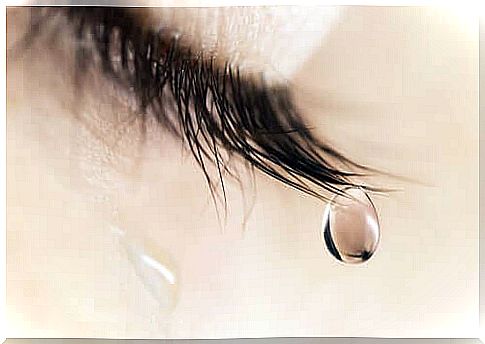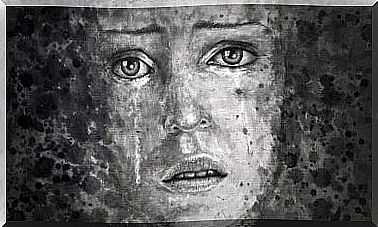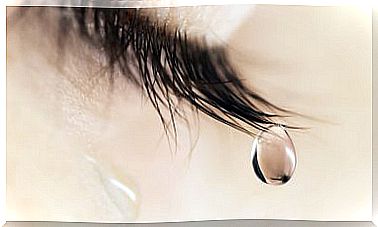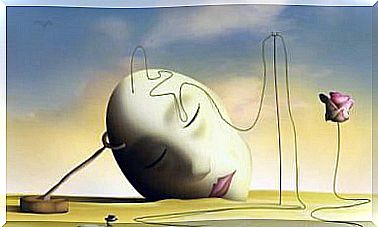The Bitterness Of Unshed Tears

Sometimes a deep anguish comes over us. A knot forms in our throat and our mind seems locked into a dead end. Sadness makes its arrival, while helplessness traps us. We can’t do anything, no matter how hard we try. Even tears don’t have the courage to look through our eyes. They can’t roll down our cheeks and make us feel better. What’s going on ? Why don’t we cry? Learn more here with us about the bitterness of unshed tears.
There are many people who, after suffering from a negative situation of great impact, are unable to relieve their pain. They were so moved by what happened that they were sort of stuck. Locked in a suffering which deprives them of any possibility of expressing their feelings.
It’s a bitter feeling. They want to cry and they can’t. They even want to put words to what is invading them, but they are unable to. The problem is, the discomfort gets bigger and bigger, as if, little by little, the unshed tears are drowning them from the inside. Go further.

Why can’t I cry?
The inability to cry can be associated with various causes: from illness to emotional blockages, hence the importance of first eliminating any cause at the physiological level.
For example, Sjögren’s syndrome is an autoimmune disease characterized by the destruction of the glands that produce tears and saliva, but which can also damage other parts of the body. This causes symptoms such as dry eyes and mouth. For this reason, it is important to see a doctor, rather than assuming that what has happened is due to psychological issues, such as depression.
Psychological causes of unshed tears
Once the physiological causes have been ruled out, it’s time to navigate the person’s psychological universe to find out what is going on. In this case, it is important to keep in mind that not all people deal with problems in the same way. Each person has their own way of dealing with reality, their own reaction time, and their own set of strategies. Therefore, there will be those who are able to release their emotions easily, those who need more time to process what has happened, and those who for whatever reason are stuck due to the strong impact received.
So, when the problem has a psychological origin, it is usually related to poor management of emotions. It can be somewhat ad hoc, but can also lead to depression and other factors. Even if the inability to cry is experienced during a grieving process and this is prolonged over time, it may indicate the presence of pathological mourning.
However, it is important to keep in mind what it means to cry for the person, because there is sometimes the belief that it is something negative or weak by the education received. As a result, many people tend to suppress their tears for fear that they will be seen as fragile or vulnerable, until it becomes automatic. Or, they may even be afraid to come into contact with themselves. The problem is, this is not beneficial to their health and sometimes makes it easier to build up anger, rage and aggression, or even somatization.
Emotional release from tears
William Frey, a doctor at Saint Paul Ramsay Medical Center, says tears are as necessary as smiles. Although they do not have the power to resolve what is happening to us, they ease tension, relieve sadness, and allow the person to get to know and communicate with others.
Tears are part of us, they are a defense and relief mechanism, that is, a way to release the accumulated tension, whatever the situation. It is therefore important to allow yourself to express them. Lauren Bylsman, a researcher at the University of Pittsburgh, says crying helps the body return to its state of homeostasis – that is, to regain its balance after being disturbed.

According to a study by biochemist William H. Frey, tears shed in a negative or dramatic situation release endorphins. But also prolactin, potassium chloride and magnesium as well as adenocorticotropin and leucine-encephalin. This relieves our physical and emotional discomfort due to the sensation produced by this emotional outburst.
Emotional relief techniques
Refusing to cry or being unable to cry leads to a buildup of discomfort. It’s like being adrift in an ocean of suffering, with no rescuers or land in sight. However, there are a few strategies that can help us release the built-up tension and possibly begin to express our first tears:
- Mental void: it is a technique to descend into our depths. The first step is to ask yourself what makes us sad or keeps us from feeling good. Once these problems have been identified, we will try to answer ourselves in the first person: “I feel…”, “it hurts me…” and then we will think about how to act in the future and what we could do to achieve tranquility. that we need so much
- Therapeutic Writing : Writing is a way of removing what we feel. It is then a question of freeing our feelings and unraveling the inner web that paralyzes us so much. This exercise consists of writing about our feelings without thinking about what remains. The important thing is to do it naturally
- Belief Review: It is important to inquire about our concept of crying. Perhaps we could uncover some restrictions or myths that, if we banish them, will allow us to cry. Thoughts such as “crying is for the weak”, “men don’t cry” or “crying will not solve anything” are an example.
- Talk to someone you trust : Having someone who listens to us, welcomes us and supports us can be an option to feel understood and to release what we are feeling. However, not everyone is capable of it. You have to find someone who conveys confidence, security and calm
As we see, crying is a liberating and healthy act. This behavior is able to transform the experienced tension into an expression of our inner world. It helps us release the inner pressure we are sometimes trapped in. That is, it facilitates emotional release and relaxes us. This way we will start to feel more secure and we will be able to see what happened from a different perspective.
Tears also communicate; in fact, they are seen as a call for empathy and support from others. They appear when words fail to describe what overflows the soul. When we are unable to describe what we are feeling because of the intensity of our emotions.
Crying is not a sign of weakness, but of courage. The courage to communicate the depth of our feelings, of what we feel. As the American writer Washington Irving put it: “ There is sacredness in tears. These are not signs of weakness, but of strength. They are the messengers of immeasurable sorrow and unspeakable love ”.










